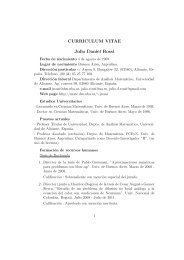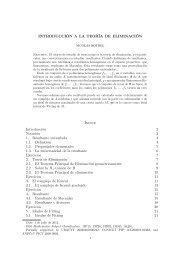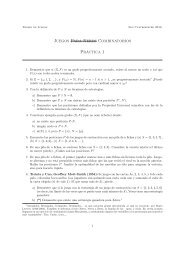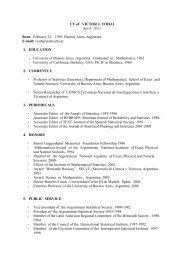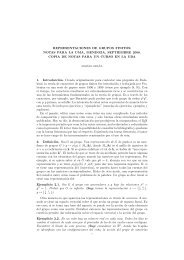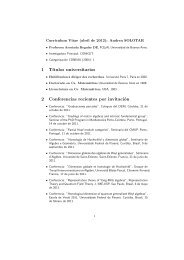You also want an ePaper? Increase the reach of your titles
YUMPU automatically turns print PDFs into web optimized ePapers that Google loves.
5. INTERPOLACIÓN DE HERMITE 105<br />
p(x1) = a0 + ha1 + h 2 a2 = f(x0) + f ′ (x0)h + a2h 2<br />
Para que se satisfaga la condición (iii) debe ser<br />
a2 = f(x1) − f(x0) − f ′ (x0)h<br />
h 2<br />
<br />
f(x1) − f(x0)<br />
=<br />
h<br />
− f ′ <br />
1<br />
(x0)<br />
h .<br />
Observemos que límx1→x0 f[x0, x1] = f ′ (x0) por lo que resulta natural generalizar la primer<br />
diferencia dividida poniendo<br />
f[x0, x0] = f ′ (x0).<br />
De esta manera se obtiene, de la definición de segunda diferencia dividida,<br />
f[x0, x0, x1] = f[x0, x1] − f[x0, x0]<br />
x1 − x0<br />
y por lo tanto, a2 = f[x0, x0, x1].<br />
<br />
f(x1) − f(x0)<br />
=<br />
h<br />
− f ′ <br />
1<br />
(x0)<br />
h<br />
Por último, queremos que p ′ (x1) = f ′ (x1). Entonces, debemos elegir a3 para que se cumpla<br />
de dónde,<br />
O sea<br />
f ′ (x1) = a1 + 2a2h + a3h 2 = f ′ (x0) + 2f[x0, x0, x1]h + a3h 2<br />
a3 = 1<br />
h2 ′<br />
f (x1) − f ′ (x0) − 2f[x0, x0, x1]h <br />
= 1<br />
h 2 (f[x1, x1] − f[x0, x0] − 2f[x0, x0, x1]h)<br />
= 1<br />
h 2 (f[x1, x1] − f[x0, x1] + f[x0, x1] − f[x0, x0] − 2f[x0, x0, x1]h)<br />
= 1<br />
h (f[x0, x1, x1] + f[x0, x0, x1] − 2f[x0, x0, x1])<br />
= f[x0, x1, x1] − f[x0, x0, x1]<br />
.<br />
x1 − x0<br />
a3 = f[x0, x0, x1, x1].







